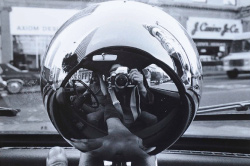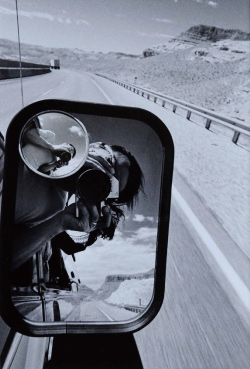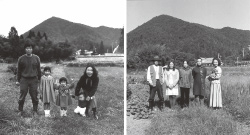Reviews
PPAS Special Feature Article

 Self-portraits taken in the U.S.
Self-portraits taken in the U.S. 20 years of change shown through family photos.
20 years of change shown through family photos.Left: First family photo in 1983.
Right: 20th photo in 2002.
Encounters with photography
I went to the United States as an exchange art student on a Fulbright Scholarship in 1975, and it was then I really started to take an interest in photography. At first, I started studying in the filmmaking department as I was interested in the video art that had been attracting some attention in technological terms around that time. However, this proved to be far beyond me as I had no fundamental knowledge of filmmaking. Also, my minimal English skills made it difficult to take lectures in which specialized chemical terms and technological knowledge were prominent. So, I decided to give up and transferred to the photography department. This “transfer” proved to be the starting point in a lifelong dedication to art.
Prior to this, back in Japan, I had presented mainly silkscreen artwork as a print artist, and had relied on professional photographers when photos were needed for my work. As they were taken by somebody else, and not me, I was not able to acquire the style required to express myself fully, and, therefore, I chose the department of photography to learn more about specialized techniques.
Later, I realized it was not that easy in reality as English skills were essential to study in an American university alongside other students who had already gained a basic knowledge of the area. Although I lacked knowledge and experience, I gradually managed to learn theory and techniques through a combination of mistakes and experimentation. The overall experience here had a huge influence on my work and lifestyle.
Various encounters during those university days changed my view of photography, as, up to that time, I had really only perceived photographs as a tool used in advertising and not really art. This is why I was so shocked when I saw such fresh and lively artwork created by photography students. I also had a chance to meet Ansel Adams through an introduction by the U.S. Department of State, as a young visiting artist on the exchange program. He is a universally respected landscape photographer of places of great natural beauty, such as Colorado and Yosemite, and, at that time, was already one of the best-known photographers in the world. It was one of the luckiest and most dream-like encounters of my life.
One year before this, in 1974, the “New Japanese Photography” exhibition was held at the New York Museum of Modern Art, with works by some Japanese modern artists, including Eiko Hosoe, Shomei Tomatsu, and Daido Moriyama. I knew nothing about any of them at that time, but Mr. Adams was not contemptuous of my ignorance, rather he graciously spent some of his precious time on me. He was a really kind person and told me not to be afraid of making mistakes and encouraged me to try anything I wanted. I have maintained this as my basic philosophy for both myself and the education of my students. Due to this encounter with the great photographer, I feel I should always be kind and broad-minded toward others. It was a short but really valuable experience for me and I believe it fundamentally changed my attitude toward the creation of art. An artist is not evaluated only by one of his/her works, and an artwork is not evaluated by itself alone. Artworks created by an artist have a relationship to each other and show the whole picture of the artist’s style and concept. Therefore, if one work is not accepted, it is not a failure but a milestone in the creative activities of an artist.
My first photographic works were self-portraits taken in the U.S., making myself a subject in order to try and understand myself in a foreign country. Since then, self-portraits have been part of my lifework, used as a method to maintain the core concept of knowing who I really am. Another aspect of my lifework are the family photos I took in front of my house for 20 years starting in 1983. This series of photos expressed not only the changes to the scenery and the family, but also my way of life.
One of the most important elements in my art creations is the concept of time. I believe my works have been created through “given” opportunities as part of a continuous time line or time loop. As I have always tried to capture specific time axes in the circulation of time, I have naturally been creating works under the concept of continuance.
I could not imagine how extensive the influence of the number of encounters and countless mistakes I experienced during my stay in the U.S. At first, I just wanted to learn something in the country, but my fellow students and professors, on the contrary, asked me hundreds of questions about Japan and Asia. At that time, I did not have the right answers to their questions about the history and culture of my own country and felt myself pathetic. This is why I still ask the questions, “Who am I?” and “What is my identity?” and this has always been my fundamental pursuit as an artist, rather than methods of expression, such as photography and pinhole photos.
After coming back to Japan, I began a quest for the meaning of “coincidence and consequence” as I deeply came to feel we are all integrated with nature or the universe. Since then, I have studied the shapes and colors of the symbols that appear in Hinduism, Esoteric Buddhism, Taoism, the art of divination and Yin-Yang and the Five Elements, mainly from Asian countries, such as India, China, Korea, Tibet and Japan, and express them through my artworks.


